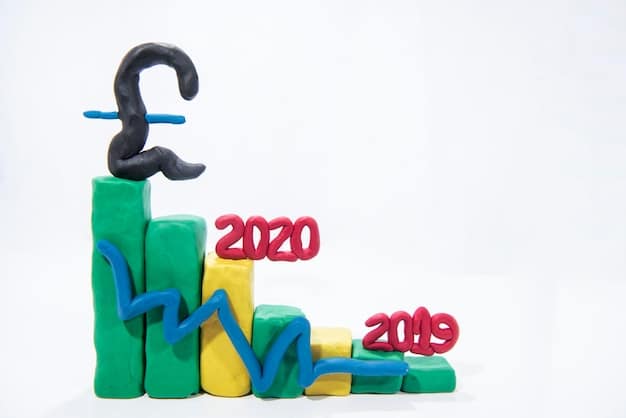Unlock Compound Interest: Grow $100/Month to $50,000 in 25 Years

Unlocking the power of compound interest reveals that investing just $100 per month can potentially grow to $50,000 in 25 years through strategic investments and consistent contributions, showcasing the long-term benefits of early and regular investing.
Have you ever wondered how small, consistent investments can turn into substantial savings over time? Unlocking the power of compound interest is the key, and it’s more accessible than you might think.
Understanding the Magic of Compound Interest
Compound interest is often called the “eighth wonder of the world,” and for good reason. It’s a powerful tool that can significantly boost your investment returns over the long term. But what exactly is it, and how does it work?
What is Compound Interest?
At its core, compound interest is earning interest on your initial investment (the principal) as well as on the accumulated interest from previous periods. This means your money grows exponentially, rather than linearly.
The Formula for Compound Interest
The formula for calculating compound interest is: A = P (1 + r/n)^(nt), where:
- A = the future value of the investment/loan, including interest
- P = the principal investment amount (the initial deposit or loan amount)
- r = the annual interest rate (as a decimal)
- n = the number of times that interest is compounded per year
- t = the number of years the money is invested or borrowed for
This formula can seem intimidating, but understanding it helps illustrate the power of compounding. Even small changes in the interest rate or the length of the investment period can have a significant impact on the final amount.
In essence, compound interest allows your money to make money, and then that money makes even more money. This snowball effect is what makes it such a valuable concept for investors.
Starting Small: The $100 per Month Strategy
Many people believe that you need a large sum of money to start investing, but that’s simply not true. Investing just $100 per month can be a powerful strategy for building wealth over time, thanks to the magic of compound interest.
Why $100 per Month?
Investing $100 per month is an accessible and manageable amount for many people. It’s a great starting point for those who are new to investing or who have limited funds available.
Consistency is Key
The real power of this strategy lies in its consistency. By investing $100 every month, you’re not only taking advantage of compound interest, but you’re also practicing disciplined saving and investing habits.
How to Automate Your Investments
One of the best ways to ensure you stick to your $100 per month investment plan is to automate it. Most brokerage accounts allow you to set up automatic transfers from your bank account to your investment account on a regular basis.

Starting small and staying consistent can lead to significant financial gains over time. The $100 per month strategy is a testament to the power of disciplined investing and the magic of compound interest.
Choosing the Right Investments
While consistently investing $100 per month is important, where you invest that money is equally crucial. The right investment choices can significantly impact your returns and help you reach your financial goals faster.
Understanding Your Risk Tolerance
Before you start investing, it’s important to understand your risk tolerance. This refers to your ability and willingness to withstand potential losses in your investments.
Popular Investment Options
Here are a few popular investment options to consider:
- Stocks: Represent ownership in a company and offer the potential for high returns, but also come with higher risk.
- Bonds: Represent loans to a government or corporation and are generally considered less risky than stocks.
- Mutual Funds: Pooled investments that hold a variety of stocks, bonds, or other assets, offering diversification.
- ETFs (Exchange-Traded Funds): Similar to mutual funds, but trade on stock exchanges like individual stocks.
- Real Estate: Investing in physical properties can provide rental income and potential appreciation, but also requires significant capital and management.
Diversification: Spreading Your Risk
Diversification is a key strategy for managing risk in your investment portfolio. By spreading your investments across different asset classes, industries, and geographic regions, you can reduce the impact of any single investment performing poorly.
By carefully considering your risk tolerance and diversifying your investments, you can maximize your potential returns while minimizing your exposure to risk.
The Power of Time
Time is one of the most important factors in unlocking the full potential of compound interest. The longer you invest, the more your money can grow.
The Impact of Early Investing
Starting to invest early in life can make a huge difference in your long-term financial success. Even if you can only invest a small amount each month, the earlier you start, the more time your money has to grow.
The Cost of Delaying
Delaying investing, even by a few years, can significantly reduce your potential returns. The longer you wait, the more you miss out on the power of compound interest.
Realistic Expectations
While aiming for $50,000 in 25 years with a $100 monthly investment is a good goal, remember that investment returns are not guaranteed. Market fluctuations can impact your actual returns, so it’s important to have realistic expectations and be prepared for potential ups and downs.

Time is a valuable asset when it comes to investing. Starting early, staying consistent, and having realistic expectations can help you harness the power of compound interest and achieve your financial goals.
Potential challenges and how to overcome them
Investing, while beneficial, isn’t without its challenges. Understanding these potential hurdles and preparing for them can help you stay on track and achieve your financial goals.
Market Volatility
The stock market can be volatile, with prices fluctuating up and down. This can be unsettling, especially for new investors.
Unexpected expenses
Life is full of unexpected expenses, such as medical bills, car repairs, or home maintenance. These expenses can derail your investment plans if you’re not prepared.
Emotional Investing
Emotions can play a significant role in investment decisions. Fear and greed can lead to impulsive buying or selling, which can negatively impact your returns.
By anticipating potential challenges and taking steps to mitigate them, you can increase your chances of success in the world of investing.
Tracking your progress and staying motivated
Keeping track of your investment progress is essential for staying motivated and making informed decisions. Regular monitoring can help you see how far you’ve come and identify areas where you may need to adjust your strategy.
Setting clear goals
The first step in staying motivated is to set clear and specific financial goals. Knowing what you’re working towards can help you stay focused and committed to your investment plan.
Reviewing your portfolio regularly
Take some time each month to review your investment portfolio. This will give you a snapshot of your current asset allocation and help you identify any potential issues or opportunities.
Celebrating milestones
Acknowledge and celebrate your achievements along the way. Reaching milestones, such as hitting a specific savings target, can provide a sense of accomplishment and boost your motivation.
By tracking your progress, celebrating your achievements, and staying connected with your financial goals, you can maintain your motivation and build long-term wealth through the power of compound interest.
| Key Point | Brief Description |
|---|---|
| 🚀 Compound Interest | Interest earned on principal and accumulated interest. |
| 💰 $100/Month | Accessible starting point for many investors. |
| ⏳ Time is Key | Earlier investments allow more time for growth. |
| 🎯 Set Goals | Stay motivated by setting and tracking clear financial goals. |
Frequently Asked Questions
The formula is A = P (1 + r/n)^(nt), where A is the future value, P is the principal, r is the annual interest rate, n is the number of times interest is compounded yearly, and t is the number of years.
Starting early gives your investments more time to grow through compound interest, potentially resulting in a significantly larger final amount compared to starting later.
Common options include stocks, bonds, mutual funds, and ETFs. Each has varying levels of risk and potential returns, so choose based on your risk tolerance and financial goals.
Set clear financial goals, automate your investments, regularly review your portfolio, and celebrate your milestones to stay motivated and on track with your investment plan.
During market downturns, it’s important to remain calm, avoid impulsive decisions, and remember your long-term investment goals. Consider it an opportunity to buy more at lower prices.
Conclusion
Unlocking the power of compound interest by investing just $100 per month offers a tangible path to potentially reaching $50,000 in 25 years. The journey necessitates consistent contributions, strategic investment choices, and a clear understanding of market dynamics, but the rewards of disciplined, long-term investing can be substantial, underscoring the importance of starting early and staying committed to your financial goals.





